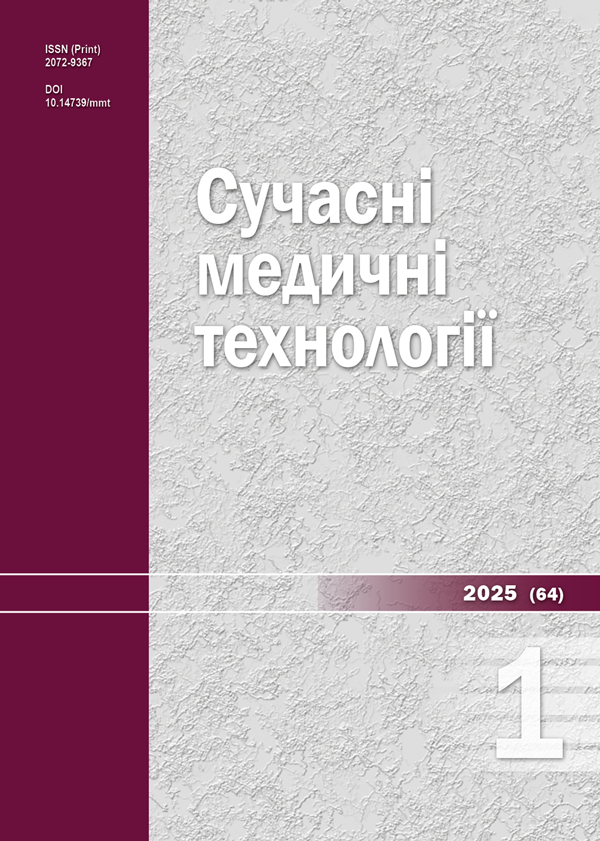Regulation of the ratio of neurotransmitters and matrix metalloproteinases is a new strategy for secondary prevention of patients with multifocal atherosclerosis
DOI:
https://doi.org/10.14739/mmt.2025.1.314543Keywords:
multifocal generalized atherosclerosi, serotonin, dopamine, MMPAbstract
Multifocal atherosclerosis (MAS) remains one of the key problems of modern medicine, despite advances in primary and secondary prevention of myocardial infarction (MI) and ischemic stroke (IS). MAS worsens the prognosis and increases the risk of atherosclerotic plaque (AP) destabilization, especially under the influence of matrix metalloproteinases (MMPs). Activation of the sympatho-adrenal and serotonergic systems with the release of dopamine and serotonin also plays a significant role in the pathogenesis of this process, influencing the regulation of vascular tone and blood flow in various organs.
The aim of this study was to study the possibilities of normalizing the balance of serotonin and dopamine in patients with MAS to stabilize the atherosclerotic process and improve the regional hemodynamics of the heart, brain, and lower extremities.
Materials and methods. The study involved 54 men aged 60 to 90 years, including the first group (n = 26) patients with MAS with intermittent claudication, atherosclerotic encephalopathy and post-infarction cardiosclerosis; the second group (n = 28) patients with MAS who had IS, with concomitant atherosclerosis of the coronary and femoral arteries, and the control group – 18 people of comparable age. Examination: ankle-brachial index, Holter ECG monitoring, walking distance, dopplerography with determination of volumetric blood flow indicators. Blood levels of serotonin, dopamine, MMP-2 and MMP-9 were determined. Cognitive function was assessed using the Montreal scale. In addition, patients of both groups were prescribed cilostazol (50 mg twice a day), GABA – aminalon (250 mg twice a day) and atenolol (25 mg once a day).
Results. The results of the study showed significant disorders of hemodynamics and neurotransmitter balance in patients with MAS. We found a significant (p < 0.001) excess of serotonin in the blood serum, an increase of dopamine (p < 0.01) by 60–70 % more than in control group persons. The morning peak of a 5–7-fold increase in plasma serotonin levels is noteworthy. Levels of MMP-2 and MMP-9 were almost twice as high (p < 0.01) in patients who experienced IS or MI compared with the control group. After the addition of cilostazol, aminalon and atenolol to the basic therapy, we found a significant decrease in the ultra-high levels of serotonin in blood plasma (p < 0.001) and serum (p < 0.05). The levels of MMP-2 (p < 0.01) decreased, volumetric blood flow indicators improved in all three studied arteries (p < 0.05), the painless walking distance and maximum walking distance increased, and cognitive functions improved significantly (p < 0.05).
Conclusions. The proposed new strategy for secondary prevention of cardiovascular events in patients with MAS with a history of ischemic stroke or myocardial infarction is based on the correction of the imbalance of neurotransmitters serotonin and dopamine by adding to the basic therapy, according to the latest guidelines 2024, a complex of drugs – cilostazol, aminalon and atenolol.
References
Gornik HL, Aronow HD, Goodney PP, Arya S, Brewster LP, Byrd L, et al. 2024 ACC/AHA/AACVPR/APMA/ABC/SCAI/SVM/SVN/SVS/SIR/VESS Guideline for the Management of Lower Extremity Peripheral Artery Disease: A Report of the American College of Cardiology/American Heart Association Joint Committee on Clinical Practice Guidelines. Circulation. 2024;149(24):e1313-e1410. doi: https://doi.org/10.1161/CIR.0000000000001251
Libby P. The changing landscape of atherosclerosis. Nature. 2021;592(7855):524-33. doi: https://doi.org/10.1038/s41586-021-03392-8
Paraskevas KI, Geroulakos G, Veith FJ, Mikhailidis DP. Multifocal arterial disease: clinical implications and management. Curr Opin Cardiol. 2020;35(4):412-6. doi: https://doi.org/10.1097/HCO.0000000000000746
Mandaglio-Collados D, Marín F, Rivera-Caravaca JM. Peripheral artery disease: Update on etiology, pathophysiology, diagnosis and treatment. Med Clin (Barc). 2023;161(8):344-50. English, Spanish. doi: https://doi.org/10.1016/j.medcli.2023.06.005
Aday AW, Matsushita K. Epidemiology of Peripheral Artery Disease and Polyvascular Disease. Circ Res. 2021;128(12):1818-32. doi: https://doi.org/10.1161/CIRCRESAHA.121.318535
Li T, Li X, Feng Y, Dong G, Wang Y, Yang J. The Role of Matrix Metalloproteinase-9 in Atherosclerotic Plaque Instability. Mediators Inflamm. 2020;2020:3872367. doi: https://doi.org/10.1155/2020/3872367
Wang LY, Tan CS, Lai MK, Hilal S. Factors Associated with RANTES, EMMPIRIN, MMP2 and MMP9, and the Association of These Biomarkers with Cardiovascular Disease in a Multi-Ethnic Population. J Clin Med. 2022;11(24):7281. doi: https://doi.org/10.3390/jcm11247281
Olejarz W, Łacheta D, Kubiak-Tomaszewska G. Matrix Metalloproteinases as Biomarkers of Atherosclerotic Plaque Instability. Int J Mol Sci. 2020;21(11):3946. doi: https://doi.org/10.3390/ijms21113946
Wang X, Khalil RA. Matrix Metalloproteinases, Vascular Remodeling, and Vascular Disease. Adv Pharmacol. 2018;81:241-330. doi: https://doi.org/10.1016/bs.apha.2017.08.002
Nikbakhtzadeh M, Bordbar S, Seyedi S, Ranjbaran M, Ashabi G, Kheradmand A. Significance of Neurotransmitters in Cerebral Ischemia: Understanding the Role of Serotonin, Dopamine, Glutamate, and GABA in Stroke Recovery and Treatment. Cent Nerv Syst Agents Med Chem. 2024 Aug 19. doi: https://doi.org/10.2174/0118715249302594240801171612
Wang Y, Wang X, Zhang X, Chen S, Sun Y, Liu W, et al. D1 receptor-mediated endogenous tPA upregulation contributes to blood-brain barrier injury after acute ischaemic stroke. J Cell Mol Med. 2020;24(16):9255-66. doi: https://doi.org/10.1111/jcmm.15570
Bahr FS, Ricke-Hoch M, Ponimaskin E, Müller FE. Serotonin Receptors in Myocardial Infarction: Friend or Foe? ACS Chem Neurosci. 2024;15(8):1619-34. doi: https://doi.org/10.1021/acschemneuro.4c00031
Neumann J, Hofmann B, Dhein S, Gergs U. Role of Dopamine in the Heart in Health and Disease. Int J Mol Sci. 2023;24(5):5042. doi: https://doi.org/10.3390/ijms24055042
Bradley CL, Damiano DL. Effects of Dopamine on Motor Recovery and Training in Adults and Children With Nonprogressive Neurological Injuries: A Systematic Review. Neurorehabil Neural Repair. 2019;33(5):331-44. doi: https://doi.org/10.1177/1545968319837289
Legg LA, Tilney R, Hsieh CF, Wu S, Lundström E, Rudberg AS, et al. Selective Serotonin Reuptake Inhibitors for Stroke Recovery. Stroke. 2020;51(8):e142-3. doi: https://doi.org/10.1161/STROKEAHA.120.029329
Maitland S, Baker M. Serotonin syndrome. Drug Ther Bull. 2022;60(6):88-91. doi: https://doi.org/10.1136/dtb.2021.000032
Mazzolai L, Teixido-Tura G, Lanzi S, Boc V, Bossone E, Brodmann M, et al. 2024 ESC Guidelines for the management of peripheral arterial and aortic diseases. Eur Heart J. 2024;45(36):3538-700. doi: https://doi.org/10.1093/eurheartj/ehae179
Belal A, Elanany MA, Santali EY, Al-Karmalawy AA, Aboelez MO, Amin AH, et al. Screening a Panel of Topical Ophthalmic Medications against MMP-2 and MMP-9 to Investigate Their Potential in Keratoconus Management. Molecules. 2022;27(11):3584. doi: https://doi.org/10.3390/molecules27113584
García-Salazar LF, Ribeiro JA, Cunha JE, Mattiello SM, Luiz Russo T. Serum activity of matrix metalloproteinase-2 and -9 is increased in chronic post-stroke individuals: a cross-sectional exploratory study. Top Stroke Rehabil. 2022;29(8):605-15. doi: https://doi.org/10.1080/10749357.2021.1956048
Marquez-Romero JM, Díaz-Molina R, Hernández-Curiel BC, Bonifacio-Delgadillo DM, Prado-Aguilar CA. Matrix metalloproteinase-2 and matrix metalloproteinase-9 serum levels in patients with vertebrobasilar dolichoectasia with and without stroke: case-control study. Neuroradiology. 2022;64(6):1187-93. doi: https://doi.org/10.1007/s00234-021-02869-7
Martini R, Ageno W, Amato C, Favaretto E, Porfidia A, Visonà A. Cilostazol for peripheral arterial disease – a position paper from the Italian Society for Angiology and Vascular Medicine. Vasa. 2024;53(2):109-19. doi: https://doi.org/10.1024/0301-1526/a001114
Stinear CM. Dopamine for motor recovery after stroke: where to from here? Lancet Neurol. 2019;18(6):514-5. doi: https://doi.org/10.1016/S1474-4422(19)30162-0
Villa M, Martínez-Vega M, Del Pozo A, Muneta-Arrate I, Gómez-Soria A, Muguruza C, et al. The Role of the Dopamine System in Post-Stroke Mood Disorders in Newborn Rats. Int J Mol Sci. 2023;24(4):3229. doi: https://doi.org/10.3390/ijms24043229
Lee MY, Kim NH, Ko JS. Protective Effect of Cilostazol Against Restraint Stress Induced Heart Failure in Post-Myocardial Infarction Rat Model. Chonnam Med J. 2020 Sep;56(3):180-185. doi: https://doi.org/10.4068/cmj.2020.56.3.180
Lyzogub VG, Savchuk OM, Kupchynska OG, Motsak TM. Disorders of neuromediator pool in patients with multifocal atherosclerosis. World of Medicine and Biology. 2021;(2):74-8. doi: https://doi.org/10.26724/2079-8334-2021-2-76-74-78
Motsak T, Lizogub V, Kupchynska E, Bugaytsev A. [The level of serotonin in patients with generalized atherosclerosis and its dynamics under the influence of cilostazol]. Ukrainian scientific medical youth journal. 2020;(2):44-7. Ukrainian. doi: https://doi.org/10.32345/USMYJ.2(116).2020.44-57
Paparella I, Vanderwalle G, Stagg CJ, Maquet P. An integrated measure of GABA to characterize post-stroke plasticity. Neuroimage Clin. 2023;39:103463. doi: https://doi.org/10.1016/j.nicl.2023.103463
Gergs U, Pham TH, Rayo Abella LM, Hesse C, Grundig P, Dhein S, et al. Contractile effects of stimulation of D1-dopamine receptors in the isolated human atrium. Naunyn Schmiedebergs Arch Pharmacol. 2024 Aug 5. doi: https://doi.org/10.1007/s00210-024-03340-z
Downloads
Additional Files
Published
How to Cite
Issue
Section
License
Copyright (c) 2025 Motsak T. M., Lyzogub V. G., Kupchynska O. H.

This work is licensed under a Creative Commons Attribution-NonCommercial 4.0 International License.
The work is provided under the terms of the Public Offer and of Creative Commons Attribution-NonCommercial 4.0 International (CC BY-NC 4.0). This license allows an unlimited number of persons to reproduce and share the Licensed Material in all media and formats. Any use of the Licensed Material shall contain an identification of its Creator(s) and must be for non-commercial purposes only.














